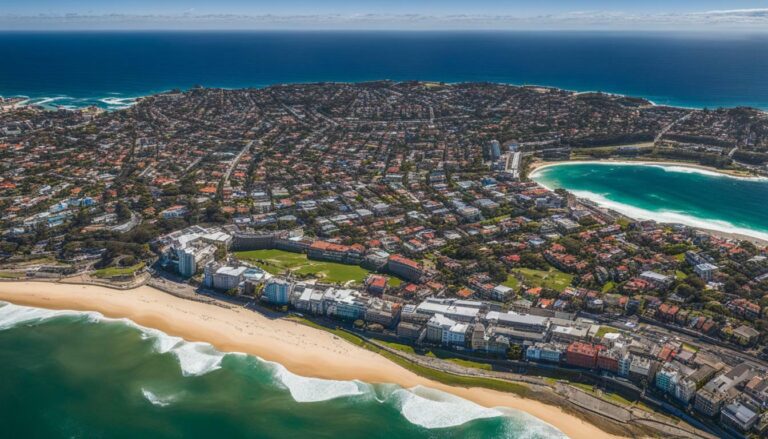What is the Record High Temperature in Bondi Beach Australia?
Bondi Beach, Australia holds a record for its scorching high temperatures, with the hottest day ever recorded reaching a staggering 47.3 degrees Celsius (117 Fahrenheit) in January 2018.
Key Takeaways:
- The highest recorded temperature in Bondi Beach, Australia is 47.3 degrees Celsius (117 Fahrenheit), recorded in January 2018.
- This temperature was just shy of Sydney’s all-time high of 47.8 degrees Celsius, set in 1939.
- The hot weather prompted the activation of the state’s heatwave plan.
- Power outages and total fire bans were implemented due to the extreme heat.
- Residents were advised to drink extra water and limit their time outdoors due to the air pollution caused by the heat.
Bondi Beach Australia Climate and Weather Statistics
To understand the record-breaking temperatures in Bondi Beach, it is essential to delve into the region’s climate and examine its weather statistics. Located in New South Wales, Australia, Bondi Beach experiences a temperate climate influenced by the oceanic currents. The area enjoys mild winters and warm summers, with average temperatures ranging from 16 to 26 degrees Celsius (61 to 79 degrees Fahrenheit).
Rainfall in Bondi Beach is fairly evenly distributed throughout the year, with an annual average of around 1,220 millimeters (48 inches). The wettest months are usually between January and March, while the drier months occur from May to September. Humidity levels are generally moderate, making Bondi Beach a pleasant destination for outdoor activities.
When it comes to extreme weather events, Bondi Beach has witnessed its fair share. In January 2018, the highest temperature ever recorded in the area spiked at a scorching 47.3 degrees Celsius (117 Fahrenheit). This heatwave not only caused discomfort for residents but also led to power outages and total fire bans to mitigate the risk of wildfires.
Additionally, the high temperatures brought about poor air quality due to increased pollution. The combination of heat and pollutants can have adverse effects on respiratory health, prompting authorities to issue health advisories and encourage residents to stay hydrated and limit their exposure to outdoor air pollution.
| Climate Data | January | February | March | April | May | June | July | August | September | October | November | December |
|---|---|---|---|---|---|---|---|---|---|---|---|---|
| Average High (°C) | 26 | 26 | 25 | 23 | 20 | 18 | 17 | 18 | 20 | 22 | 24 | 25 |
| Average Low (°C) | 19 | 19 | 18 | 15 | 12 | 10 | 9 | 10 | 12 | 15 | 17 | 18 |
| Average Rainfall (mm) | 94 | 118 | 142 | 152 | 131 | 130 | 119 | 84 | 76 | 68 | 75 | 89 |
Bondi Beach Australia’s Hottest Day on Record
Let’s take a closer look at the exact day when Bondi Beach experienced its hottest temperature on record and the extreme conditions that accompanied it. The scorching heat hit a staggering 47.3 degrees Celsius (117 Fahrenheit) in January 2018, making it the highest recorded temperature ever in this iconic beach destination. It was a day that left locals and visitors alike feeling the intense heat.
The blistering weather not only broke records but also triggered the activation of the state’s heatwave plan. Power outages became a reality, as the demand for electricity soared, causing strain on the power grid. To make matters worse, total fire bans were implemented to mitigate the risk of bushfires, as the extreme temperatures posed a significant threat.
In response to the heatwave and subsequent poor air quality, residents were advised to drink ample amounts of water and limit their time outdoors. The high temperatures contributed to air pollution, exacerbating respiratory conditions and making it challenging for people with respiratory issues to breathe comfortably.
The temperature extremes experienced on that day serve as a reminder of the impact that climate change is having on our environment. As extreme weather events become more frequent, it is crucial that we take proactive measures to mitigate their effects and protect our communities.
Comparison with Sydney’s Temperature Record
While Bondi Beach holds an impressive temperature record, it is worth noting how it compares to Sydney’s all-time high temperature. In January 2018, Bondi Beach experienced scorching temperatures of 47.3 degrees Celsius (117 Fahrenheit), just shy of Sydney’s record of 47.8 degrees Celsius set back in 1939. These extreme temperatures triggered the activation of the state’s heatwave plan and had significant impacts on the local community.
During this heatwave, Bondi Beach and the surrounding areas faced power outages as the demand for electricity soared. The intense heat also led to total fire bans, highlighting the serious fire risk posed by the extreme weather conditions. Government authorities advised residents to stay hydrated and limit their time outdoors due to high levels of air pollution caused by the heat and associated factors.
The comparison between Bondi Beach and Sydney’s temperature records serves as a reminder of the potential for extreme weather events in this part of Australia. It underscores the importance of preparedness and proactive measures to mitigate the impacts of such high temperatures. Understanding historical temperature records can help inform strategies for managing heatwaves, protecting infrastructure, and safeguarding the well-being of communities in the future.
| Location | Record High Temperature | Year |
|---|---|---|
| Bondi Beach | 47.3°C | 2018 |
| Sydney | 47.8°C | 1939 |
Bondi Beach Australia Heat Wave History
Heatwaves have been a recurring phenomenon in Bondi Beach, Australia, with a history that unveils the region’s vulnerability to extreme heat. The coastal suburb has experienced several significant heatwaves over the years, with temperatures soaring well above average and posing various challenges for both residents and the local authorities.
One notable heatwave took place in January 2018 when Bondi Beach recorded its highest temperature on record at 47.3 degrees Celsius (117 Fahrenheit). The scorching heat prompted the activation of the state’s heatwave plan, which aimed to ensure the safety and well-being of the community. Power outages were reported as the electrical infrastructure struggled to cope with the increased demand for cooling, while total fire bans were imposed to prevent the risk of wildfires in the dry and sweltering conditions.
The heatwave also had detrimental effects on the air quality in Bondi Beach. With the high temperatures, the air became heavily polluted, posing health risks to vulnerable individuals. The authorities advised residents to limit their time outdoors, stay hydrated, and take necessary precautions to avoid heat-related illnesses.
Notable Bondi Beach Heat Waves:
| Year | Temperature | Impacts |
|---|---|---|
| 2018 | 47.3°C (117°F) | Power outages, total fire bans, air pollution |
| 2009 | 45.3°C (113°F) | Health warnings, increased demand for cooling |
| 2004 | 44.8°C (112°F) | Water shortages, heat-related illnesses |
As climate change continues to exacerbate extreme weather events, including heatwaves, it is crucial for Bondi Beach and its residents to be prepared for future occurrences. This involves implementing effective heatwave management strategies, investing in resilient infrastructure, and raising awareness about the importance of climate adaptation. By acknowledging the heatwave history and taking proactive measures, Bondi Beach can strive towards a more resilient and sustainable future.
Impacts of High Temperatures in Bondi Beach Australia
The scorching temperatures in Bondi Beach have far-reaching consequences, affecting the region’s infrastructure, environment, and people’s health. The record high temperature of 47.3 degrees Celsius (117 Fahrenheit) in January 2018 had a significant impact on the area.
One of the immediate consequences of such extreme heat is power outages. As the demand for electricity soars during heatwaves, the strain on the power grid can lead to blackouts, leaving residents without essential services. This not only disrupts daily life but also poses risks to vulnerable individuals who rely on air conditioning for relief from the sweltering heat.
The scorching temperatures also result in total fire bans being enforced in the region. With dry and arid conditions exacerbated by the heat, the risk of wildfires becomes extremely high. Authorities implement restrictions on activities that may spark fires, such as barbecues or the use of power tools, to prevent potentially devastating fires from breaking out and spreading rapidly.
Furthermore, the intense heat contributes to increased air pollution in Bondi Beach. As temperatures rise, pollutants in the atmosphere react with sunlight to form ground-level ozone, a harmful component of smog. This poses a threat to the respiratory health of residents, particularly those with pre-existing conditions such as asthma or allergies. It is crucial for individuals to limit their exposure to outdoor air during heatwaves and take necessary precautions to protect their well-being.
| Impacts of High Temperatures in Bondi Beach Australia | Measures to Mitigate |
|---|---|
| Power outages | Conserve electricity, limit use of appliances, and seek cooling shelters if necessary. |
| Total fire bans | Adhere to fire safety regulations, avoid activities that could ignite fires, and report any signs of wildfires promptly. |
| Air pollution | Minimize time spent outdoors, especially during peak pollution hours, and keep windows closed to reduce exposure to smog. |
“The extreme heat in Bondi Beach can have severe consequences for the local community. It is essential for residents to stay well-informed about the risks and take necessary precautions to safeguard their health and the environment.” – Local Authority
Conclusion
In conclusion, Bondi Beach, Australia, has experienced record-breaking high temperatures, with the mercury soaring to 47.3 degrees Celsius (117 Fahrenheit) on its hottest day in January 2018. This scorching temperature came close to Sydney’s all-time high of 47.8 degrees Celsius (118 Fahrenheit) recorded back in 1939. The extreme heat triggered the implementation of the state’s heatwave plan, resulting in power outages and total fire bans across the region.
During this heatwave, residents were advised to take precautions such as staying hydrated by drinking extra water and limiting their time outdoors. The high temperatures also led to increased air pollution in the area, further exacerbating the already challenging conditions.
With the threat of climate change and rising global temperatures, it is becoming increasingly important to monitor and address the impacts of extreme heat events. As demonstrated by the scorching temperatures in Bondi Beach, these heatwaves can have significant consequences, including power disruptions, fire risks, and compromised air quality. It is crucial for individuals, communities, and governments to take action to mitigate these effects and ensure the well-being and safety of all.
FAQ
Q: What is the record high temperature in Bondi Beach, Australia?
A: The record high temperature in Bondi Beach, Australia is 47.3 degrees Celsius (117 Fahrenheit), which was recorded in January 2018.
Q: How does Bondi Beach’s record high temperature compare to Sydney’s all-time high?
A: Bondi Beach’s record high temperature of 47.3 degrees Celsius is just shy of Sydney’s all-time high of 47.8 degrees Celsius, set in 1939.
Q: What happened during the hot weather in Bondi Beach?
A: The hot weather in Bondi Beach prompted the activation of the state’s heatwave plan and resulted in power outages and total fire bans. Residents were advised to drink extra water and limit their time outdoors due to the air pollution caused by the heat.







